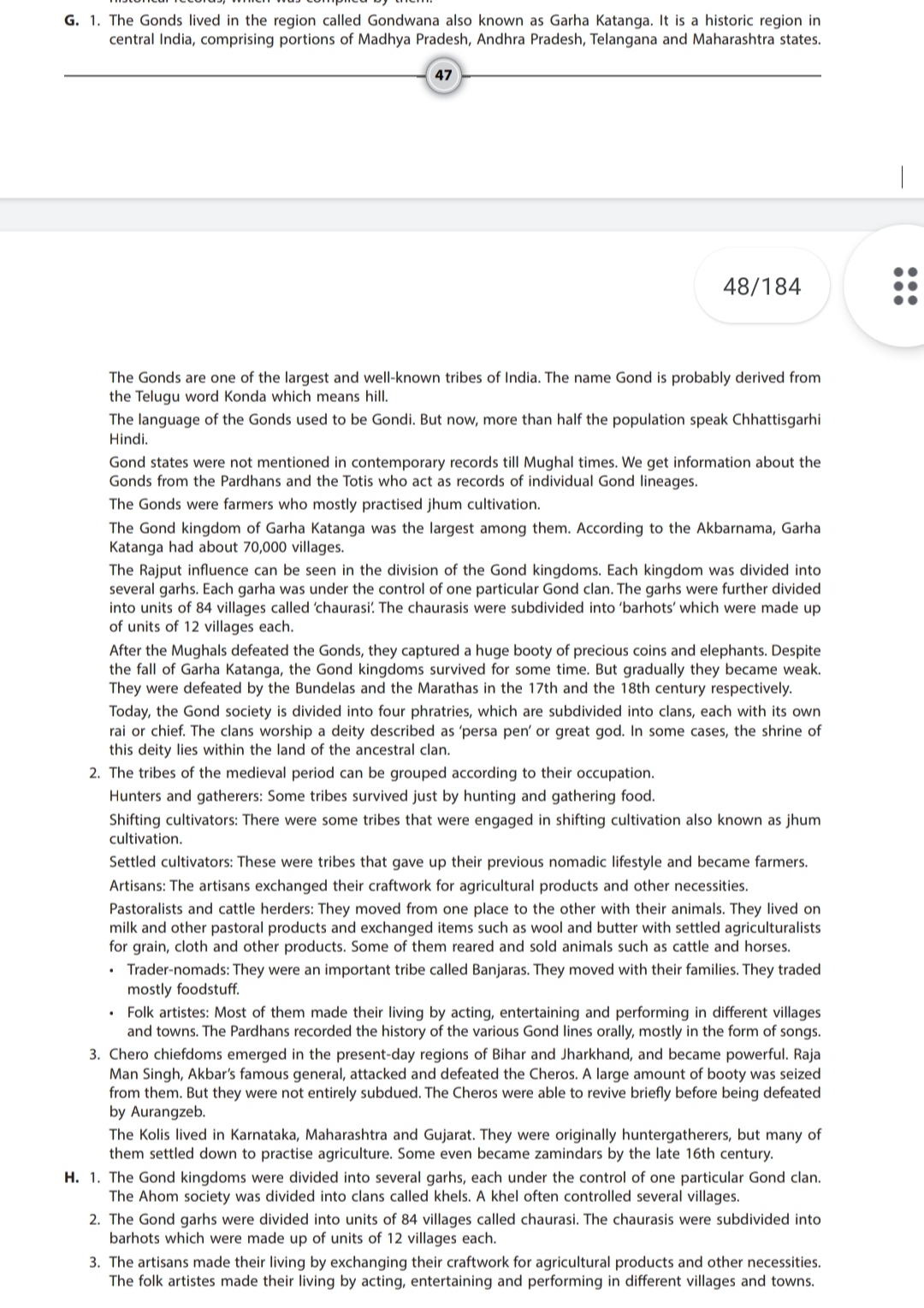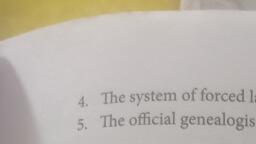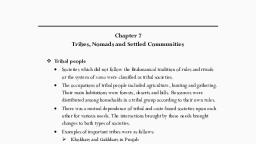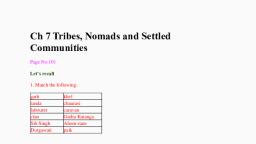Page 1 :
G. 1. The Gonds lived in the region called Gondwana also known as Garha Katanga. It is a historic region in, , central India, comprising portions of Madhya Pradesh, Andhra Pradesh, Telangana and Maharashtra states., , , , @, , 48/184, , The Gonds are one of the largest and well-known tribes of India. The name Gond is probably derived from, the Telugu word Konda which means hill., , The language of the Gonds used to be Gondi. But now, more than half the population speak Chhattisgarhi, Hindi., , Gond states were not mentioned in contemporary records till Mughal times. We get information about the, Gonds from the Pardhans and the Totis who act as records of individual Gond lineages., , The Gonds were farmers who mostly practised jhum cultivation., , The Gond kingdom of Garha Katanga was the largest among them. According to the Akbarnama, Garha, Katanga had about 70,000 villages., , The Rajput influence can be seen in the division of the Gond kingdoms. Each kingdom was divided into, several garhs. Each garha was under the control of one particular Gond clan. The garhs were further divided, into units of 84 villages called ‘chaurasi. The chaurasis were subdivided into ‘barhots’ which were made up, of units of 12 villages each., , After the Mughals defeated the Gonds, they captured a huge booty of precious coins and elephants. Despite, the fall of Garha Katanga, the Gond kingdoms survived for some time. But gradually they became weak., They were defeated by the Bundelas and the Marathas in the 17th and the 18th century respectively., Today, the Gond society is divided into four phratries, which are subdivided into clans, each with its own, rai or chief. The clans worship a deity described as ‘persa pen’ or great god. In some cases, the shrine of, this deity lies within the land of the ancestral clan., , . The tribes of the medieval period can be grouped according to their occupation., , Hunters and gatherers: Some tribes survived just by hunting and gathering food., , Shifting cultivators: There were some tribes that were engaged in shifting cultivation also known as jhum, cultivation., , Settled cultivators: These were tribes that gave up their previous nomadic lifestyle and became farmers., , Artisans: The artisans exchanged their craftwork for agricultural products and other necessities., , Pastoralists and cattle herders: They moved from one place to the other with their animals. They lived on, , milk and other pastoral products and exchanged items such as wool and butter with settled agriculturalists, , for grain, cloth and other products. Some of them reared and sold animals such as cattle and horses., , «+ Trader-nomads: They were an important tribe called Banjaras. They moved with their families. They traded, mostly foodstuff., , + Folk artistes: Most of them made their living by acting, entertaining and performing in different villages, and towns. The Pardhans recorded the history of the various Gond lines orally, mostly in the form of songs., , . Chero chiefdoms emerged in the present-day regions of Bihar and Jharkhand, and became powerful. Raja, , Man Singh, Akbar’s famous general, attacked and defeated the Cheros. A large amount of booty was seized, from them. But they were not entirely subdued. The Cheros were able to revive briefly before being defeated, by Aurangzeb., , The Kolis lived in Karnataka, Maharashtra and Gujarat. They were originally huntergatherers, but many of, them settled down to practise agriculture. Some even became zamindars by the late 16th century., , . The Gond kingdoms were divided into several garhs, each under the control of one particular Gond clan., , The Ahom society was divided into clans called khels. A khel often controlled several villages., , . The Gond garhs were divided into units of 84 villages called chaurasi. The chaurasis were subdivided into, , barhots which were made up of units of 12 villages each., , . The artisans made their living by exchanging their craftwork for agricultural products and other necessities., , The folk artistes made their living by acting, entertaining and performing in different villages and towns.




























































